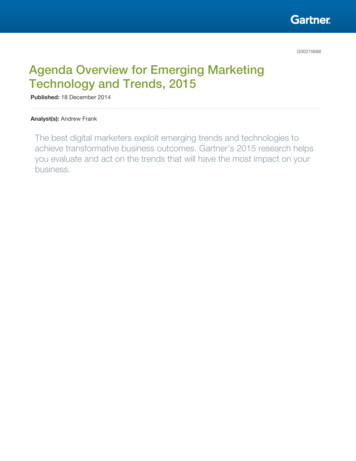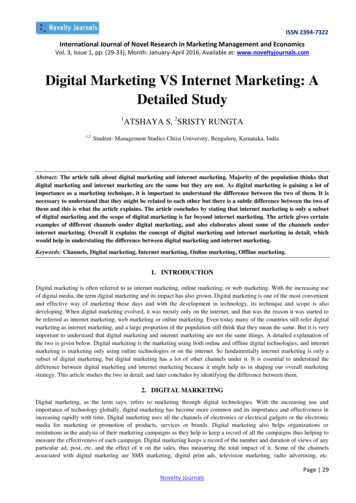
Transcription
G00270688Agenda Overview for Emerging MarketingTechnology and Trends, 2015Published: 18 December 2014Analyst(s): Andrew FrankThe best digital marketers exploit emerging trends and technologies toachieve transformative business outcomes. Gartner's 2015 research helpsyou evaluate and act on the trends that will have the most impact on yourbusiness.
AnalysisFigure 1. Emerging Marketing Technology and Trends Agenda OverviewSource: Gartner (December 2014)New technologies and trends emerge continually, and many marketers focus tactically on choosingwhich to try and which to ignore. As a result, their digital marketing evolves gradually, withtomorrow looking much like today. However, technologies and trends that seem to emerge one byone periodically coalesce into a whole new set of scenarios for marketing. When this happens,brands that anticipate these transformational scenarios will thrive; incrementalists will lose out.Gartner's 2015 emerging trends research will sketch the high-impact scenarios we see emerging,showing you how to position your brand for success.Our 2015 research will describe the most important emerging technologies and how digitalmarketers will have to use them to succeed in the era of digital business.Page 2 of 8Gartner, Inc. G00270688
Key Issues What digital marketing trends and techniques on the horizon will change or disrupt currentmarketing practices? How should marketers evaluate the business potential of a new digital trend or technique? How are digital marketers acting on emerging trends and techniques for business advantage?What digital marketing trends and techniques on the horizon will change or disruptcurrent marketing practices?Today, marketers address people's needs and intentions. In the future, marketers will moreconfidently anticipate people's needs. Under the current scenario, people and businesses interactvia search, promotional content, social media and e-commerce. In emerging digital businessscenarios, people, businesses and things will connect via location-based services, programmedtriggers and intelligent agents (imagine an Apple Siri that acts on your behalf). For example, when awindow in your house is broken by a storm at night, your smart home system may assess thedamage and decide to notify your insurance company of the loss before you wake up. Theinsurance company, in turn, may work with your digital personal assistant to assign a glass repaircontractor and schedule an appointment that morning.Will your brand be a part of this transaction? Digital business scenarios require marketers to mastera new set of disciplines, not simply install new technology: Identify scenarios in which your company's offerings could play a role, and work with othercompanies that might be part of the solution to create value networks. Gather data from internal and external sources about who the customer is, what they do, whatthey like. Use predictive analytics to anticipate their needs. Develop systems that can interact with your partners' systems in real time and generate offersprogrammatically. Work with your distribution team to make sure your company can deliver its product or servicewithin the parameters required by the scenario — for example, is scheduled delivery feasible?Planned ResearchOur 2015 research will use "business moments" — scenarios composed of a cascade ofinteractions among people, businesses, and things — to elaborate new digital marketingopportunities and the emerging trends and technologies underpinning them. We will track suchtrends in news analysis, Impact Appraisals and Gartner Predicts research. We will track the maturityof emerging technologies in Hype Cycles and on the emerging technology track of Gartner's DigitalMarketing Transit Map (see "Hype Cycle for Digital Marketing, 2014"). We will also cover newtechnology providers in Cool Vendors reports. Established providers also offer emergingtechnologies that we will cover in Magic Quadrants (focused on particular markets) and VendorRatings (focused on particular vendors).Gartner, Inc. G00270688Page 3 of 8
How should marketers evaluate the business potential of a new digital trend ortechnique?Marketers that excel in managing innovation for business advantage recognize that newtechnologies have three distinct levels of impact: First-order impacts deliver immediate value to customers and brands by offering moreconvenience and better experience to the former, and more data and sales opportunities to thelatter. Examples include personalized store experiences (both physical and digital) that guide amobile shopper directly to products of interest. Second-order impacts create new revenue streams from aggregated behaviors that can scalebeyond the initial service or product. Examples include enhancing product-based digitalservices and/or making money from high-volume data feeds collected by sensors embedded indevices, products or environments. Third-order impacts occur when a technology-enabled trend becomes widespread enough toaffect an entire industry or society as a whole, often in a disruptive way. Examples include thepotential impact of 3D printing on manufacturing or drone delivery schemes on local retail.Innovative marketers assess the impact of new technologies on each level and prioritizeinvestments and timing accordingly. They recognize the technologies that are poised for third-orderimpact by creating new signals that anticipate customer demand and address them with long-termplans without losing sight of short-term opportunities.Planned ResearchOur 2015 research will review best practices for evaluating emerging trends and their relevance. Wewill expand and update the Gartner Digital Marketing Transit Map and the drill-down report "Travelthe Emerging Technology Track in Gartner's Digital Marketing Transit Map." Also, we will provideexamples of companies that exploit emerging trends well and offer some toolkits to help with thepractical steps of setting up an evaluation program — for instance: "Toolkit: What's the New Blackon the 2014 Digital Marketing Hype Cycle?" Finally, we will write about providers of emergingtechnologies as in "Innovative Tech Providers for Chief Marketing Technologists to Consider."How are digital marketers acting on emerging trends and techniques for businessadvantage?Skilled marketers make use of emerging technologies by applying revenue and savings accruedfrom first-order impact technology adoption to fund investment in second- and third-orderendeavors. Higher-order impacts are likely to require collaboration with business units and strategicpartners beyond the compass of marketing, but you can take a leadership role in thesecollaborations if you: Demonstrate capacity to adopt new technologies and experiences that deliver measurablebusiness value. Identify and visualize trends and opportunities that will impact business in one to three years.Page 4 of 8Gartner, Inc. G00270688
Evaluate and prioritize investments by business value and risk.You need to set up an explicit, regular process for finding and testing emerging trends andtechnologies (think agile marketing methodologies) that push your competitive edge higher, alongwith plans to exploit them at scale.Planned ResearchOur 2015 research promises to describe best practices for applying emerging trends andtechnologies to your critical marketing goals. For example, we recently published "Ensure EmergingTrends and Technologies Advance Your Marketing Strategy," "How Digital Marketers Will TakeAdvantage of the Internet of Things" and "How to Approach Customer-Focused DigitalTransformation." We will base these best practices on what the leading companies are doing todayand where they are headed tomorrow. Our continued survey analysis will provide clear pictures ofwhat the innovators are doing to gain a competitive edge.Related PrioritiesKey Initiatives address significant business opportunities and threats, and typically have definedobjectives, substantial financial implications, and high organizational visibility. They are normallyimplemented by a designated team with clear roles and responsibilities, as well as definedperformance objectives.Gartner, Inc. G00270688Page 5 of 8
Table 1. Related Priorities for Emerging Marketing Technology and TrendsKey InitiativeFocusCustomerExperienceCustomer experience encompasses the sum of all brand interactions across customer-facingtouchpoints in sales, marketing and support, across a brand's products, processes — andeven people.MultichannelMarketingMultichannel marketing represents a coordinated program across digital and traditional mediato acquire and retain customers, extend the brand, condition the market and engagecommunities.Data-DrivenMarketingData-driven marketing refers to acquiring, analyzing and applying all information aboutcustomer and consumer wants, needs and motivations.Mobile MarketingMobile marketing involves using information about people's context (location, identity,relationships and intentions) to tailor information and products that will increase customerengagement and sales.Digital CommerceDigital commerce uses the Internet, mobile networks and commerce infrastructure to executetransactions with consumers or businesses and to support marketing and other activitiesaround these transactions.Social MarketingSocial marketing is a strategy that uses social media to listen to and engage customers, andcultivate brand advocates. It can shorten product development cycles, boost innovation andincrease conversion rates.Source: Gartner (December 2014)Suggested Next Steps Use cross-functional innovation centers to evaluate new trends and technologies from multipleperspectives; provide measurable incentives for innovation and cooperation. Develop a prioritization framework to prioritize research and development investment based onalignment with business goals and risks. Have marketing take the lead in assessing top-linegrowth potential for emerging scenarios. Establish a culture that values learning and insights at least as highly as conditional success;design controlled experiments to test hypotheses and resolve key questions as part of asystematic process of discovery.Gartner Recommended ReadingSome documents may not be available as part of your current Gartner subscription."Toolkit: Digital Marketing Hype Cycle — Engagement on Overdrive""Survey Shows CEOs See Leading Role for Marketing in Digital Business""Cool Vendors in Data-Driven Marketing, 2014"Page 6 of 8Gartner, Inc. G00270688
"Understand Marketing's Role in Digital Business""Realize the Marketing Impact of New Technology"Agenda Manager ProfileAs VP Distinguished Analyst with Gartner for Marketing Leaders, Andrew Frank specializes in bestpractices for data-driven marketing, including how organizations can use data to drive sales, loyalty,innovation, brand value and other business goals.Mr. Frank has spent more than 28 years focusing on technology-driven innovation for major mediacompanies, ad agencies, and startups, and the last 15 focused on interactive marketing andInternet development, providing him with knowledge not only of the technologies, but also of thebusiness goals and practices of media and advertising companies.More on This TopicThis is part of an in-depth collection of research. See the collection: Agenda Overviews for Gartner for Marketing Leaders, 2015Gartner, Inc. G00270688Page 7 of 8
GARTNER HEADQUARTERSCorporate Headquarters56 Top Gallant RoadStamford, CT 06902-7700USA 1 203 964 0096Regional HeadquartersAUSTRALIABRAZILJAPANUNITED KINGDOMFor a complete list of worldwide locations,visit http://www.gartner.com/technology/about.jsp 2014 Gartner, Inc. and/or its affiliates. All rights reserved. Gartner is a registered trademark of Gartner, Inc. or its affiliates. Thispublication may not be reproduced or distributed in any form without Gartner’s prior written permission. If you are authorized to accessthis publication, your use of it is subject to the Usage Guidelines for Gartner Services posted on gartner.com. The information containedin this publication has been obtained from sources believed to be reliable. Gartner disclaims all warranties as to the accuracy,completeness or adequacy of such information and shall have no liability for errors, omissions or inadequacies in such information. Thispublication consists of the opinions of Gartner’s research organization and should not be construed as statements of fact. The opinionsexpressed herein are subject to change without notice. Although Gartner research may include a discussion of related legal issues,Gartner does not provide legal advice or services and its research should not be construed or used as such. Gartner is a public company,and its shareholders may include firms and funds that have financial interests in entities covered in Gartner research. Gartner’s Board ofDirectors may include senior managers of these firms or funds. Gartner research is produced independently by its research organizationwithout input or influence from these firms, funds or their managers. For further information on the independence and integrity of Gartnerresearch, see “Guiding Principles on Independence and Objectivity.”Page 8 of 8Gartner, Inc. G00270688
practices for data-driven marketing, including how organizations can use data to drive sales, loyalty, innovation, brand value and other business goals. Mr. Frank has spent more than 28 years focusing on technology-driven innovation for major media companies, ad agencies, and startups, and the last 15 focused on interactive marketing and











